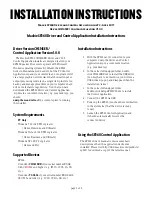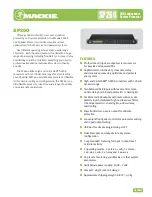
•
Associating event notifications with trapsinks (all SNMP versions)
•
View definition (V3 only)
•
Group and user configuration (V3 only)
X9000 Software implements an SNMP agent on the management console that supports the private
X9000 Software MIB. The agent can be polled and can send SNMP traps to configured trapsinks.
Setting up SNMP notifications is similar to setting up email notifications. You must associate events
to trapsinks and configure SNMP settings for each trapsink to enable the agent to send a trap
when an event occurs.
Configuring the SNMP agent
The SNMP agent is created automatically when the management console is installed. It is initially
configured as an SNMPv2 agent and is off by default.
Some SNMP parameters and the SNMP default port are the same, regardless of SNMP version.
The agent port is 161 by default.
SYSCONTACT
,
SYSNAME
, and
SYSLOCATION
are optional MIB-II
agent parameters that have no default values.
The
-c
and
-s
options are also common to all SNMP versions. The
-c
option turns the encryption
of community names and passwords on or off. There is no encryption by default. Using the
-s
option toggles the agent on and off; it turns the agent on by starting a listener on the SNMP port,
and turns it off by shutting off the listener. The default is off.
The format for a v1 or v2 update command follows:
ibrix_snmpagent -u –v {1|2} [-p PORT] [-r READCOMMUNITY] [-w WRITECOMMUNITY]
[-t SYSCONTACT] [-n SYSNAME] [-o SYSLOCATION] [-c {yes|no}] [-s {on|off}]
The update command for SNMPv1 and v2 uses optional community names. By convention, the
default
READCOMMUNITY
name used for read-only access and assigned to the agent is
public
.
No default
WRITECOMMUNITY
name is set for read-write access (although the name
private
is
often used).
The following command updates a v2 agent with the write community name
private
, the agent’s
system name, and that system’s physical location:
ibrix_snmpagent -u –v 2 -w private -n agenthost.domain.com -o DevLab-B3-U6
The SNMPv3 format adds an optional
engine id
that overrides the default value of the agent’s
host name. The format also provides the
-y
and
-z
options, which determine whether a v3 agent
can process v1/v2 read and write requests from the management station. The format is:
ibrix_snmpagent -u –v 3 [-e engineId] [-p PORT] [-r READCOMMUNITY]
[-w WRITECOMMUNITY] [-t SYSCONTACT] [-n SYSNAME] [-o SYSLOCATION]
[-y {yes|no}] [-z {yes|no}] [-c {yes|no}] [-s {on|off}]
Configuring trapsink settings
A trapsink is the host destination where agents send traps, which are asynchronous notifications
sent by the agent to the management station. A trapsink is specified either by name or IP address.
X9000 Software supports multiple trapsinks; you can define any number of trapsinks of any SNMP
version, but you can define only one trapsink per host, regardless of the version.
At a minimum, trapsink configuration requires a destination host and SNMP version. All other
parameters are optional and many assume the default value if no value is specified. Trapsink
configuration for SNMPv3 is more detailed than for earlier versions. The main differences involve
the additional security parameters added by SNMPv3.
The format for creating a v1/v2 trapsink is:
ibrix_snmptrap -c -h HOSTNAME -v {1|2} [-p PORT] [-m COMMUNITY] [-s {on|off}]
If a port is not specified, the command defaults to port 162. If a community is not specified, the
command defaults to the community name
public
. The
-s
option toggles agent trap transmission
Setting up SNMP notifications
37
















































